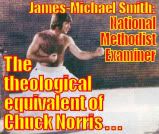 A few months ago I had the pleasure of reviewing vol. 1 of Zondervan's Illustrated Bible Backgrounds Commentary. The good folks at Zondervan sent me vol. 2 and asked that I review it as well.
A few months ago I had the pleasure of reviewing vol. 1 of Zondervan's Illustrated Bible Backgrounds Commentary. The good folks at Zondervan sent me vol. 2 and asked that I review it as well.
The overall strengths (and few weaknesses) of the series are the same from my last review, so rather than cover them again, I'll let the interested reader go there for an overview.
Vol.2 covers the books of Joshua, Judges, Ruth and 1&2 Samuel. And once again, the reader finds a wealth of visual information on the background of these books covering Israel's transitional period from wandering ex-slaves to a mighty people united under the Davidic monarchy.
There is so much that could be said about this volume to commend it, so I'll focus on a specific in order to give an idea of what to expect overall.
I was very pleased to see how ZIBBCOT treats the famous David and Goliath episode. I've written a number of articles on the account of David and Goliath and how it often gets told in a distorted manner due to it's popularity as a children's story and lack of close attention to the text. Things such as Goliath's height, armor and method of death are often overlooked or embellished for the sake of retelling. ZIBBCOT does a fantastic job of putting the reader back into the tail-end of the 2nd millennium BC with numerous images of artifacts from the period. From a section of scale armor, such as Goliath would've likely worn (p.347) to a relief depicting mealtime in an army camp (p.349), to an Egyptian depiction of a captured Philistine warrior (p.352), ZIBBCOT delivers exactly what it promises--a commentary on the world of the text with multiple illustrations to aid the reader in reconstructing the story.
However, especially refreshing was the note on 1Sam. 17:49. I other than occasional reference in a footnote here and there, I've never seen the subject of where the stone struck Goliath discussed in any detail other than the traditional view that it struck him on the forehead. But the word "forehead" in the Hebrew text is a variant of the word "greave/shin guard" that appears earlier in the chapter when describing Goliath's armor. Thus it's possible (if not likely) that the stone struck the "forehead" that Goliath was wearing on his leg (i.e. his shin armor), knocking him facedown on the ground so that David could quickly grab his sword and decapitate him with it. This alternative view is rarely found in popular commentaries on this passage, yet in ZIBBCOT we find the following:
[p.352]
Struck the Philistine on the forehead (17:49). Questions have been raised concerning whether a stone from David's sling could have struck Goliath's forehead, given the kinds of helmets that Philistines are depicted as wearing (see illustration). But the biblical text does not suggest that Goliath's armor was typical Philistine hardware but exceptional (see sidebar on "Goliath's Armor" at 17:5-7). That said, it is interesting to note that the Hebrew word rendered "greave" in verse 6 (mitscha), which occurs only here in the Hebrew Bible, is very close, if not identical, to the Hebrew word for "forehead" (metsach). Noting this curiosity, A. Deem has suggested that David's stone finds its mark not in Goliath's forehead but at the "greave" in the gap required for walking. It is difficult to decide between these two interpretations; in either case Goliath is toppled and quickly dispatched by David, using Goliath's own sword (v.51)
Thus, a small but significant detail which can very much change one's understanding of this traditional story--and one which is usually hidden away in dusty academic journals or little-used critical commentaries--is presented to the reader and explained in an easy-to-understand manner. And rather than making the argument one way or the other, ZIBBCOT simply notes the possibility and allows the reader to draw their own conclusion. This is a commendable quality in a commentary and is the norm for this series.
This is but one example among many which gives a good understanding as to the purpose, nature and approach ZIBBCOT takes. In the very helpful introductory essay "Methodology: An Introductory Essay," General Editor, John Walton, lays out the value of such background study in regard to intepreting Scripture:
Susscessful interpreters must try to understand the cultural backgroud of the ancient Near East just as successful missionaries must learn the culture, language, and worldview of the people they are trying to reach. This is the rationale for us to study the Bible in light of the ancient Near East. What we contend, then, is that comparative studies has three goals in mind:Since comparative studies is pretty foreign territory to the average Bible reader, ZIBBCOT is a crucial resource for every pastor, teacher, Bible study leader and anyone else who studies the Bible seriously to have within arms' reach. If you're looking for more information that will open up the world of ancient pre-monarchic Israel in a new and exciting way, ZIBBCOT vol.2 is tailor-made for such study. I recommend it wholeheartedly and look forward to working my way through future volumes.These goals are a the heart of comparative studies and will help us understand the OT better.
- We study the history of the ancient Near East as a means of recovering knowledge of the events that shaped the lives of people in the ancient world.
- We study archaeology as a means of recovering the lifestyle reflected in the material culture of the ancient world.
- We study the literature of the ancient Near East as a means of penetrating the heart and soul of the people who inhabited the ancient world that Israel shared.







No comments:
Post a Comment